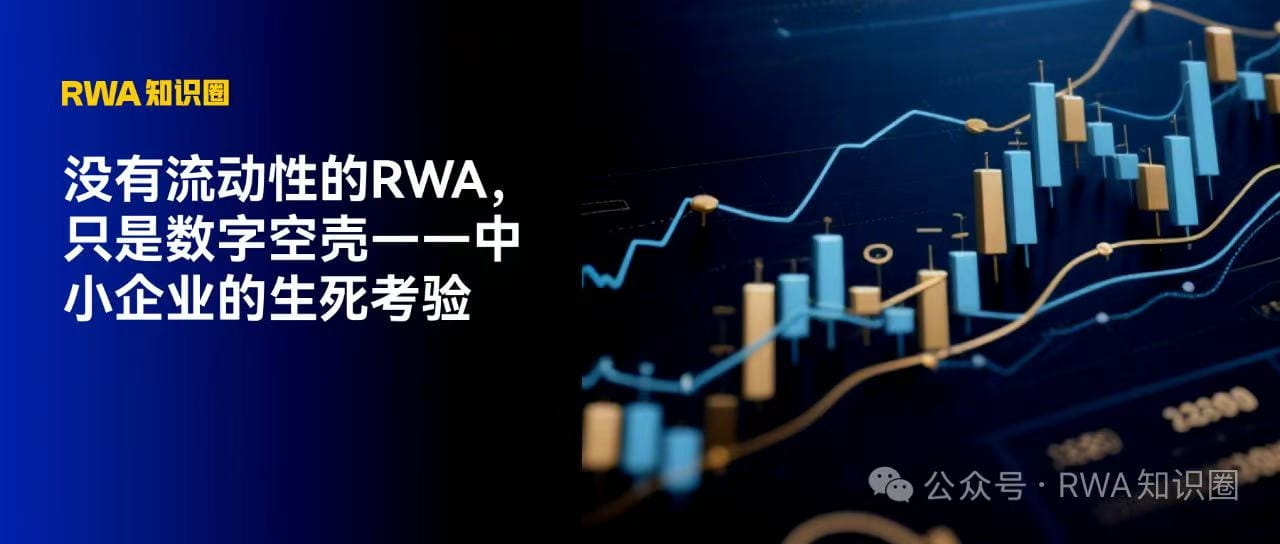
1. Concerns Under the Spotlight: The Liquidity 'Trap' of RWA
Real World Assets (RWA) are entering a critical phase from concept validation to large-scale application. Many countries and regions globally have incorporated RWA into their strategic plans, with increasing policy support and capital attention. However, amid the fervent asset blockchain wave, small and medium-sized enterprises often find themselves in an awkward position. On one hand, RWA can indeed help activate corporate assets, expand financing channels, and promote digital transformation; on the other hand, if the core issue of liquidity cannot be resolved, RWA projects often devolve into 'digital shells,' much like stocks without buyers, making it difficult to realize value. Currently, mainstream RWA platforms are still primarily supported by early institutional investors like crypto funds. Facing real challenges such as the lack of exit mechanisms and an underdeveloped secondary trading market, small and medium-sized enterprises are more likely to fall into a passive situation of 'just waiting.' This article will attempt to outline a feasible liquidity solution to help small and medium-sized enterprises break through their bottlenecks.
2. From 'Barter' to 'Currency Circulation': Modern Liquidity Insights of RWA
From the primitive barter system to the birth of currency, liquidity has always been the foundation of market prosperity. RWA tokens are essentially digital certificates of real assets, representing a mapping of ownership, usage rights, or income rights. To introduce sustainable liquidity for these tokens, they must be anchored to the 'currency of the digital world.' Stablecoins are undoubtedly one of the most liquid options, but considering the differences in regulatory environments across countries, stablecoins like USDT cannot be widely adopted in certain jurisdictions. Therefore, a 'value-anchored token' mechanism aimed at internal enterprise use is particularly important.
Small and medium-sized enterprises can build internal value anchoring mechanisms through professional RWA accelerator institutions in collaboration with smart contract development teams: using real assets (such as debts, properties, income rights, etc.) as support to issue stable tokens with liquidity functions, used to meet daily buying and selling needs. Users holding loan tokens or other rights certificates can exchange them for stable tokens at any time according to the pricing formula built into the contract, achieving instant exit and pricing settlement. The contract can dynamically adjust the exchange ratio based on factors such as discounted cash flows, market interest rates, and default rates, ensuring that asset prices approach fair value. This mechanism resembles the early RWA model of 'bartering' as it transitions to a modern market form of 'currency pricing and liquidity.'
3. From Institutional Design to Technical Implementation: The Path to Realizing RWA Liquidity
Of course, establishing this liquidity system relies not only on technological capabilities but also on carefully designed economic models and value support systems. Taking common assets for small and medium-sized enterprises, such as accounts receivable or small loans, as an example, the entire mechanism can include the following core elements:
Asset Splitting and Securitization: Packaging and splitting original loans into small tradable units, representing future income rights, allowing more investors to participate.
Protocol Takeover Mechanism: The platform reserves a certain pool of funds or native tokens for repurchasing asset tokens in the secondary market, providing basic liquidity assurance.
Smart Contract and Oracle Interaction: Using oracles to obtain real-world interest rates, risk levels, and other data, smart contracts automatically calculate and update asset values, enhancing price transparency and trading efficiency.
Asset Support Mechanism: Native tokens used for repurchase must be linked to a basket of real assets to avoid price decoupling and enhance market trust.
Among them, the category of RWA represented by private credit has already shown tremendous potential. According to statistics, the current global market size of private credit RWA has reached $15 billion, increasing by more than 50% since the beginning of the year. Since small and medium-sized enterprises are more likely to generate such short-term, high-frequency, and dispersed credit demands, if liquidity designs can be paired with them, it will undoubtedly further promote market prosperity.
4. Making Assets 'Move': The Practical Significance of Liquidity Mechanisms
A good liquidity framework not only allows investors to exit at any time, reducing holding anxiety, but also helps stabilize asset prices and suppress manipulation and arbitrage behavior. The multifunctional design of protocol native tokens—such as governance rights, insurance mechanisms, and liquidity support—also provides resilience and sustainability to the entire RWA system. From a longer-term perspective, this mechanism can even enable assets like real estate, commercial income rights, electricity, and carbon credits to truly enter the era of 'buying and selling at any time' in digital circulation.
For small and medium-sized enterprises, successfully issuing RWA assets is only the first step. To gain a foothold in a competitive market, they need to invest more resources in promotion, operation, and liquidity maintenance during the post-issue phase. The participation of professional RWA accelerators or ecosystem platforms can provide integrated services from asset modeling, technical deployment to market matching, avoiding the dilemma of 'issuing but unable to collect.' In the wave of digital assets, those who can first solve the liquidity problem are more likely to become the pioneers of the next era.
